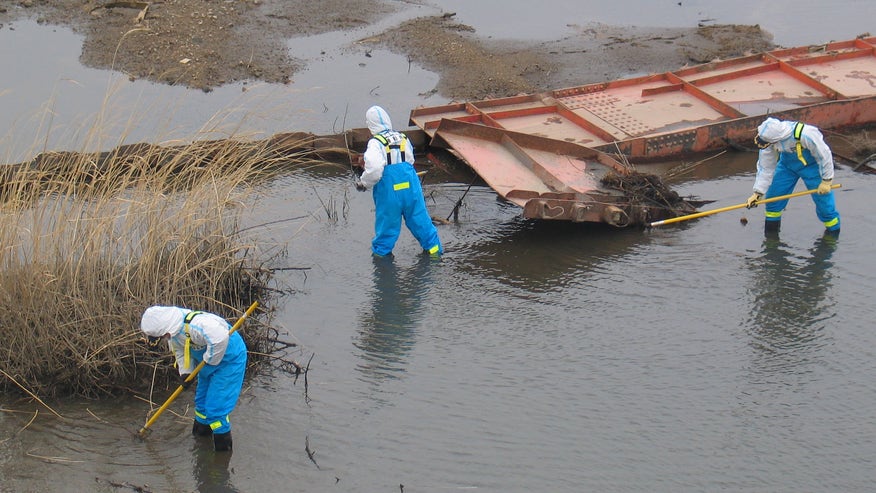More than two years after a tsunami-induced meltdown, Japan’s Fukushima Daiichi nuclear plant is still spewing contaminated water into a sea that once teemed with fishing boats but now seems eerily deserted, and the latest hope for stopping the poisonous flow is an underground ice barrier that’s never been tried.
Officials recently acknowledged that an estimated 300 tons of radiation contaminated water, which is continuously pumped into the reactors in an effort to cool them, pour into the sea every day. The plant has been leaking radiation ever since it was crippled by a massive tsunami caused by an offshore earthquake in March, 2011, that knocked out its cooling systems and led three of the four reactors to melt down. Since then, the plant’s oprators, Tokyo Electric Power, or TEPCO, has been unable to repair the walls and floor of the underground enclosures in which the reactors are situated because it’s still too dangerous for a human to work there for extended periods.
TEPCO has built an underground barrier to try to contain contaminated groundwater from reaching the sea. But despite the barrier, water can still go around or over it when heavy rains cause water to wash down from the hill where the damaged plant looms. Much of the water used is recycled through huge reservoirs dug underground but some of the water still seeps into the land, and then the sea nearby.
“There is no precedent in the world to create a water-shielding wall with frozen soil on such a large scale.”
– Japanese Chief Cabinet Secretary Yoshihide Suga
The public is growing frustrated with the company’s failure to contain and clean up the mess.
“TEPCO’s actions are reactive and slow,” Kiyoshi Takasaka, a member of a committee of nuclear experts advising Fukushima prefecture, told the Japanese media. Other members of the committee complain that TEPCO hasn’t got a convincing containment plan.
The latest idea for stopping the flow of contaminated water into the sea is to freeze the soil around the reactor buildings to create a mile-long barrier to stop more groundwater from becoming radioactive, a plan that could cost upwards of $400 million.
“There is no precedent in the world to create a water-shielding wall with frozen soil on such a large scale. To build that, I think the state has to move a step further to support its realization,” Chief Cabinet Secretary Yoshihide Suga told reporters.
While the politicians ponder whether the underground ice wall can stop the radiation leak, the grim reality is that the land and seas around the Fukushima plant continue to be polluted more.
The Japanese government recently allowed international media to travel inside the uninhabited zone around the plant, on the nation’s northeastern coast. Villages appear frozen in time, deserted, with everything left as it was when residents were evacuated. The crippled nuclear plant, whose reactors have still not cooled, is situated on a hill overlooking what were once beautiful beaches now littered with vehicles and debris from the tsunami.
Former residents are allowed to visit sometimes their former homes, but can’t stay long and face a vigorous radiation checking procedure every time they leave. The sea, was once famous across Japan for the fish it provided, is bereft of fishing boats.
Recent tests of water from wells in the area show that radioactivity is still hundreds of times above safe drinking levels.
Minoru Takata, director of the Radiation Biology Center at Kyoto University, told The Wall Street Journal that the radioactive water doesn’t pose an immediate health threat unless a person goes near the damaged reactors. But over the longer term, he’s worried that the leakage could cause higher rates of cancer in Japan. Scientists in Japan and the United States says the leaks into the Pacific Ocean pose little threat to Americans.
Despite the ongoing problem and public anger, Prime Minister Shinzo Abe supports restarting nuclear plants idled following the Fukushima disaster. Abe, who has been a strong defender of Japan’s nuclear program, has been trying to kick start Japan’s stagnant economy and the nuclear plants are a key to reducing expensive energy imports.
If the government can solve the leakage problem at the crippled nuclear plant, it may give the politicians enough support to allow them to switch on the country’s nuclear reactors again. But by taking over the problem at Fukushima it has now become his government’s problem and its future could hang on whether the ice wall works.



